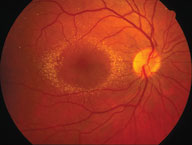Orobronze retinopathy; gold-dust retinopathy; toxic drug maculopathy; canthaxanthine crystalline deposits.
Description A crystalline maculopathy is a result of the physical accumulation of refractile crystalline deposits in the superficial retina. The condition is typically bilateral. One possible cause of crystalline maculopathy is drug toxicity, where a small proportion of the drug does not remain dissolved in the blood stream and precipitates into the tissues.
A crystalline maculopathy is a result of the physical accumulation of refractile crystalline deposits in the superficial retina. The condition is typically bilateral. One possible cause of crystalline maculopathy is drug toxicity, where a small proportion of the drug does not remain dissolved in the blood stream and precipitates into the tissues.
An orobronze (canthaxanthine) maculopathy occurs when the cumulative dose of the over-the-counter, orally-ingested skin tanning agent exceeds a critical level over a long period of time (usually years). The deposits are typically adjacent to the major vascular arcades and form a ring pattern around the macula. In addition to being used as a tanning agent, canthaxanthine and beta-carotene may be clinically taken by the patient to avert phototoxicity, and low levels of canthaxanthine are used as a food additive.
Register now to continue reading
Thank you for visiting Optician Online. Register now to access up to 10 news and opinion articles a month.
Register
Already have an account? Sign in here
